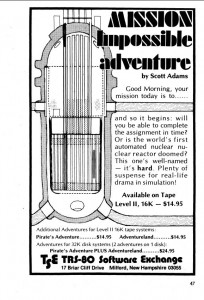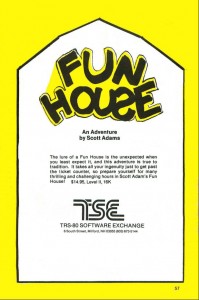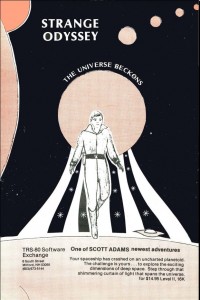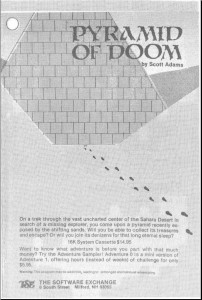To say Scott Adams had a productive 1979 doesn’t begin to tell the half of it. For starters, he released a rather staggering six complete new games: Mission Impossible, Voodoo Castle, The Count, Strange Odyssey, Mystery Fun House, and Pyramid of Doom. Of these, four were the sole work of Adams himself.
Voodoo Castle was credited to Adams’s then-wife, Alexis. Still, the real situation there is muddled, as Adams has tended to downplay her contribution in recent interviews, saying that she was responsible only for the broadest strokes, leaving him to do most of the writing and all of the programming. What with the passage of years and the difficult feelings that accompany any divorce, it’s probably not possible to know anymore whether Alexis Adams deserves to be credited as the first female adventure-game designer, beating Roberta Williams to the punch by more than a year.
More definite is the contribution of Alvin Files to Pyramid of Doom. Working independently, with no access to source code or design documents, Files reverse-engineered Adams’s adventure-game engine, created a game of his own using it, and sent the result to Adams himself, who tweaked it a bit and released it as Adventure #8, which he acknowledges to be “90 percent” Files’s original work. Pyramid of Doom was released around October of 1979, but an early sign of the budding relationship can be seen in that summer’s The Count, which is “dedicated to Alvin Files.”
In sorting out this chronology via magazines and other primary-source documents, I was quite surprised to realize that fully two-thirds of what has come to be regarded (somewhat arbitrarily) as the canonical dozen Scott Adams adventures were created before Adams’s company, Adventure International, was even founded. Said founding occurred just before the end of the year, by which time Adams was already involved in another important step: porting his adventure engine to run on other microcomputer platforms. The logical first target for these efforts was the Apple II, the second most popular machine in 1979, but within a few years the explosion of incompatible machines and Adams’s dedication to supporting as many of them as possible would bring the games to at least a dozen different platforms. While 1979 wasn’t yet the year that adventure games broke really big, it was the year that Adams laid the groundwork for their doing so, for the changing of the calendar left him poised with a new company, a portable adventure-game engine, and a nice catalog of already extant games in a wide variety of genres. He had even created a stripped-down “sampler” version of Adventureland for those looking to test these new waters.
Even on the good old TRS-80 Adams made major technical improvements. At the apparent urging of Lance Micklus, he reimplemented his interpreter using assembly language rather than BASIC between the release of Mission Impossible in the spring of 1979 and Voodoo Castle and The Count that summer, bringing enormous speed improvements. He also implemented a new display system that would become something of a trademark, with the current room description and contents always displayed in a separate, non-scrolling “window” in the upper half of the screen. Given the TRS-80’s 64-character by 16-line display and the attendant tendency for everything of interest to scroll away in no time, this amounted to a major convenience. The new interpreter even supported lower-case output, although prose style, grammar, and even spelling remained all too obviously not a big priority. With these improvements the new system, which was quickly retrofitted back into the first three games as well, made TRS-80 adventuring a much more pleasant experience.
But what of the content of the games themselves? Well, both their limited engine and the torrid pace at which Adams cranked them out acted as a necessary limit on their scope of possibility, but there are some new developments worth talking about. Chief among them is the element of time. Both the original Adventure and Adventureland had of course required close attention to time management thanks to their expiring light sources, but Mission Impossible introduced the element in a more plot-centric way, in the form of a ticking time-bomb that threatened to destroy a nuclear power plant. And two games on from that we have The Count, a game that is about as conceptually ambitious as Adams would ever get and a significant step forward for the text adventure as a storytelling medium. I’ll look at The Count, by far the most interesting of these six efforts, in some detail next time.

















Eric Fischer
March 28, 2012 at 9:03 pm
Thanks for all the great stories!
If you want a contemporary source for the story of Lance Micklus convincing Scott Adams to use machine language, it’s also in the profile (“How the Gamesman Began”) of Adams in the July, 1980 issue of 80 Microcomputing.
D.D.
April 22, 2015 at 6:25 am
Based on interviews and his own writing, Scott Adams simply doesn’t strike me as the kind of guy that would give even his own wife full credit plus dedication rights unless she really did do the overwhelming majority of the work. IMHO that you hit the nail on the head in mentioning that a bad divorce skews people’s perceptions & claims.
As far as I know, the ‘rule’ in historic research is supposed to be that when crediting a work to somebody, the original written record is considered definitive unless clear proof of inaccuracy is discovered later on. That is, unless it’s possible to get in touch with the person and ask for clarification on precisely what roles *they* claim to have fulfilled.
FWIW, I noticed that a review at the Interactive Fiction database implied that there’s a noticeable difference in “creativity” between Voodoo Castle and the other AI titles. I’ll have to give it a whirl sometime and see whether I notice anything. (My snarky side can’t help observing that being able to spell and write in standard English would make her stand out at AI. ;-) )
Jimmy Maher
April 22, 2015 at 6:43 am
I’ve learned a lot more about this subject since writing this article. And yeah, there are a lot of reasons why Scott Adams tries so hard to avoid even mentioning his wife’s name in interviews, even though she played a huge role at Adventure International. Alexis died about five years ago.
Joachim
November 23, 2015 at 5:42 pm
I’m sure you know a lot more than I do, but she did state this in an e-mail in 1998: “I helped create Adventure two. Scott and I wrote that together. I learned how to use the editor for the language Scott had designed and went on to write Adventure #4 Voodoo Castle. I also partially wrote #7 Mystery Fun House. I was cranky and pregnant around that time so Scott took it midstream while I gave birth to our second Child Aria. I also negotiated a license for Buckaroo Bonzai and we wrote an adventure to go with it. Then there was Marvel Comics as well . Scott wrote the Comics for them and the Adventure.” – http://www.alphaworks.com.au/scottadams/Alexis.htm
Unless you have any reason to doubt her word, it does seem likely that her contributions deserves a lot more recognition than they’re currently getting online.
Jimmy Maher
November 25, 2015 at 10:16 pm
The Scott and Alexis Adams story is a very strange one, much stranger than I ever imagined at the time I wrote this article. For various reasons, neither one strikes me as the most reliable of witnesses. Third-party accounts do confirm, however, that Alexis was the business brain behind Adventure International, while Scott wrote the games and served as the public face of the company. It is almost certainly true that Alexis deserves far more credit than she gets, including in this article, for having beaten Roberta Williams by a year to become the first female designer of adventure games as well as one of very few women to play a significant role in the early software industry in general. To say too much more would be to stray into some delicate areas, and I haven’t quite decided for myself where the boundaries should lie.
Ant
January 19, 2021 at 1:34 am
Should I feel bad that I keep hoping you might find some way to elaborate discreetly on this mysterious and tantalising comment..?!
Mike Taylor
January 7, 2025 at 11:51 pm
Me, too!
Gideon Marcus
February 5, 2017 at 3:38 am
The Adams’ games we finished were Pirate Adventure, Voodoo Castle, and Mystery Funhouse. We got stumped on Strange Odyssey (my 8-year old daughter used to sing E.L.O.’s “Strange Magic” but with the words “Strange Odyssey” instead), and The Count actually scared my daughter so we stopped playing it!
Primitive fare, to be sure, but really fun for family play. We discovered AI loooong after our Infocom phase — we didn’t start the above games until 2011!
Mike Taylor
October 12, 2017 at 10:19 pm
It’s pretty funny, in the Count/Voodoo Castle advert above, to see Adventureland referred to as Land Adventure. I wonder if that was just a mixup of words, or an attempt to distinguish it from the “sea adventure” of Pirate’s Cove (more often just known as Pirate Adventure).
Jimmy Maher
October 13, 2017 at 5:29 am
As you’ve kind of noted yourself, Scott Adams’s approach to his own games’ names tended to be a little bit… free-form, shall we say, in the early days.
Peter Orvetti
June 23, 2019 at 6:17 pm
I just discovered this blog a few days ago and have fallen down a Zork-worthy rabbit hole. Thank you for giving me so much information and entertainment.
Our first family computer was a TI99-4A. We had a game that I believe was a Scott Adams game, or an early imitator. I recall it was an adventure game, but the only thing I clearly recall is that when you died, the screen color turned red and you went to “Never Never Land” (or something like that) and could continue to enter commands but nothing would happen. Do you know which game this was?
Jimmy Maher
June 24, 2019 at 7:40 am
It doesn’t ring any bells, but I’m not steeped in the lore of Scott Adams and his imitators either. (Interactive fiction starts to get really interesting for me as a player only after it gets a little less primitive.) You might check with Jason Dyer: https://bluerenga.blog/. He’s been playing through lots of those very early games; I believe he’s played all of the classic dozen by Scott Adams.
Peter Orvetti
June 24, 2019 at 9:20 am
I actually found it — it was Pirate Adventure.
Will Moczarski
April 30, 2020 at 3:52 am
I accidentally backtracked here and saw that it says “Voodo Castle” in the second paragraph. I must have missed that on my last readthrough.
Jimmy Maher
May 4, 2020 at 12:45 pm
Thanks!